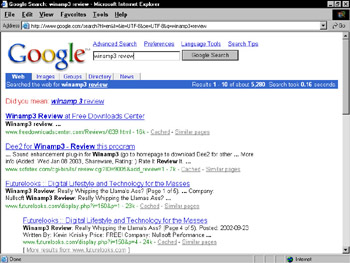Understanding the Google Results Page
|
| < Day Day Up > |
|
Every Google search results page for a Web search includes at least three basic types of information:
-
A summary of the search results
-
The search results themselves
-
A few things you can do with the results
As you can see in Figure 2-6, the results summary is located in the shaded bar, above and to the right of the results list. The summary tells you how many total results for your keywords exist in the Google index and how long the search took. (Rarely does a Google search require more than two seconds.)

Figure 2-6: A Google Web search results page. Notice the suggested spelling correction.
On the left side of the summary bar, your keywords are displayed as links. When you click one of those links, you go to Dictionary.com for a definition of the word. This seems a bit gratuitous — if you didn’t know what a word means, why would you use it as a keyword? But don’t underestimate the variety of ways that people use Google, including as a dictionary. Dictionary. com also functions as a thesaurus, so if a certain keyword isn’t delivering good results, perhaps a synonym (derived from Dictionary.com) would. Note that the links to Dictionary.com appear only when Google’s language is set to English — naturally enough, because Dictionary.com is an English dictionary.
The search results consist of the page name, which is hyperlinked to the page itself. Below that is a short bit of relevant text from the page. Below the text you can see the page’s URL, which is there for information value and is not a link. Next to the URL is a number indicating the size of the page. Glancing at the page size helps you decide whether or not to visit it; pages more than 50K (that’s 50 kilobytes) are too large for a quick visit if you don’t have high-speed Internet access.
| Remember | The Google staff doesn’t compose the page title nor the accompanying text, which explains why they’re a little goofy sometimes and incoherent other times. The page title is created by the page developer as part of the HTML code underlying all Web pages. Some page designers forget how important the page title is, or they pack in lots of words to try and get the page higher on the search results pages of search engines such as Google. (The tactic generally doesn’t work in Google, as I explain in Chapter 12.) |
The text is not necessarily descriptive of the target page or even cogent. Google clips sentences and fragments that contain your keywords and presents them as evidence that you have a good hit. This is more useful than you might think. In fact, it’s absolutely amazing how often a glance at the first few results and their accompanying text answers a search query without even visiting an outside page.
Note: The result link does not identify where on the target page your keywords are located. Not uncommonly, you link to a page and must then search in that page for relevant information — a headache when the page is long. Of course, you can always use your browser’s Find feature to locate specific words on any Web page. The problem is solved more elegantly by the Google Toolbar, as described in Chapter 9.
|
| < Day Day Up > |
|
EAN: 2147483647
Pages: 188